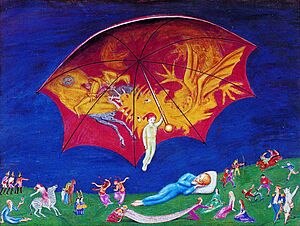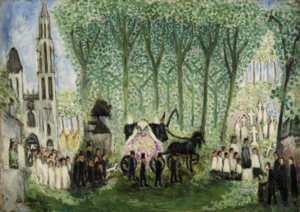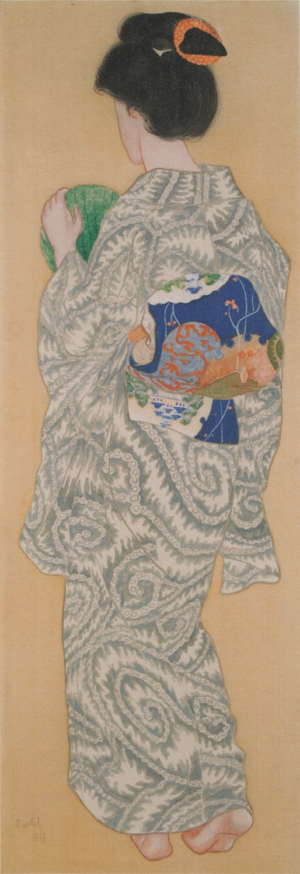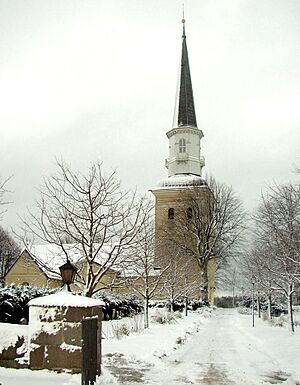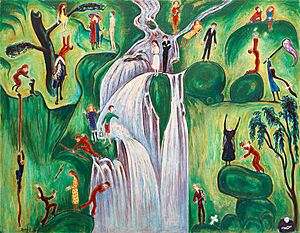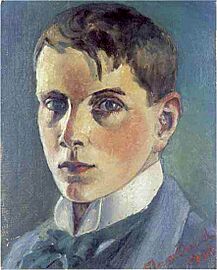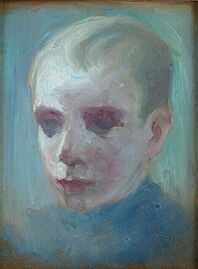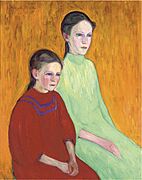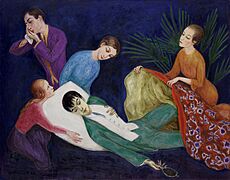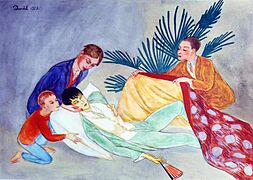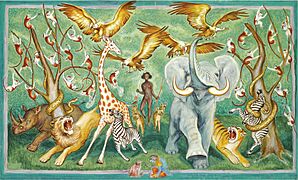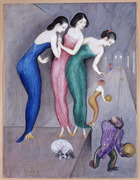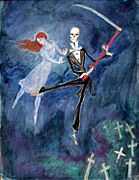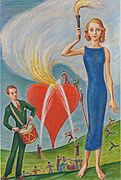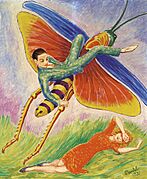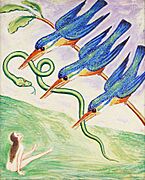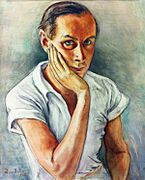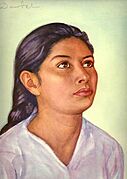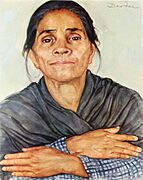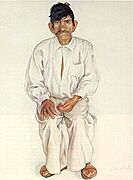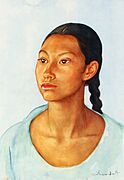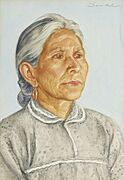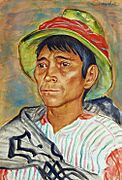Nils Dardel facts for kids
Quick facts for kids
Nils Dardel
|
|
|---|---|
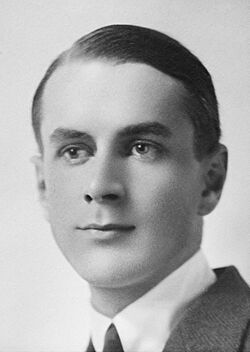
Dardel in 1917
|
|
| Born |
Nils Elias Kristofer von Dardel
25 October 1888 Bettna, Södermanland
|
| Died | 25 May 1943 (age 54) New York City
|
| Nationality | Swedish |
| Alma mater | Royal Swedish Academy of Arts |
|
Notable work
|
Den döende dandyn |
| Style | Post-Impressionism |
| Spouse(s) | Thora Dardel |
Nils Dardel (full name Nils Elias Kristofer von Dardel) was a Swedish painter from the 1900s. He was known for his unique style, often called Post-Impressionist. Nils was also the grandson of another famous Swedish painter, Fritz von Dardel.
Contents
Life of Nils Dardel
Nils Dardel was born in 1888 in a place called Bettna, in Södermanland, Sweden. He went to art school at the Royal Swedish Academy of Arts in Stockholm from 1908 to 1910. Some of his most famous paintings include Den döende dandyn (The Dying Dandy), Svarta Diana (Black Diana), and John Blund.
Dardel's Family and Art
Nils Dardel came from a noble Swedish family called von Dardel. His father was Fritz August von Dardel, a landowner. Nils's grandfather, also named Fritz von Dardel, was a painter and a member of the Royal Swedish Academy of Arts. Nils later studied at the same academy and became a member in 1934.
In 1919, Nils wanted to marry Nita Wallenberg. However, her father, who was a diplomat, did not approve. This event is thought to have inspired Nils's painting Exekution (Execution). This painting is seen as a symbol of his feelings about the rejection.
Nils Dardel married the writer Thora Dardel in 1921. Their marriage lasted until 1934. They had a daughter named Ingrid von Dardel (1922–1962). Ingrid also became an artist, just like her father. Her two sons, Henry Unger and Nils Ekwall, also became active artists in Sweden.
Artistic Journey in Paris
Around 1910, after finishing his studies in Sweden, Nils Dardel moved to Paris. Many other Swedish artists, like Leander Engström and Isaac Grünewald, also moved there at that time. In Paris, Dardel found inspiration from different art styles. He was influenced by the Fauvists, who used very bright and pure colors. He also learned from Post-Impressionist artists and from Japanese woodcut prints. For a short time, Dardel even tried painting in the Cubism style, creating a few city scenes.
Exploring Post-Impressionism
Dardel experimented with a style called Pointillism. This is where artists use small dots of color to create an image. He used strong colors and very clear subjects in his paintings. His 1913 painting Begravning i Senlis (Funeral in Senlis) is a good example of this style. He painted it while visiting the old town of Senlis. Another early painting was a portrait of a German art dealer, Alfred Flechtheim. Throughout his life, Dardel mostly painted people, focusing on portraits or groups of people.
Working with Ballets Suédois
After living in Paris for three years, Dardel became good friends with Rolf de Maré. Maré later started a dance company called the Ballets Suédois. This group performed in Paris between 1920 and 1925. Their friendship helped Dardel because Maré supported his art. Dardel also helped Maré's dance company.
In the early 1920s, Dardel created many artworks based on stage designs. These paintings look like sketches for plays or movies. Dardel also designed the stage sets for a play called Midsummer Wake and a dance drama called Maison de Fous. His painting Crime passionnel (Crime of Passion) from 1921 shows the kind of art he made during this time.
World Travels and Later Life
Nils Dardel loved to travel a lot. He visited many different countries and got ideas and subjects for his paintings from these trips. He never really settled down in one place. Many of his portraits are of people and places he met during his travels.
Nils Dardel was not widely famous during his lifetime. However, he became well-known in Sweden when World War II started in Europe. At that time, a special art show at Liljevalchs konsthall displayed many of Dardel's artworks from his life.
Nils Dardel's Legacy
Nils Dardel passed away in New York City in 1943. He was buried in Ekerö cemetery near Stockholm, Sweden.
His paintings are now shown in many important museums and galleries. These include the Nationalmuseum in Stockholm, Göteborgs konstmuseum in Gothenburg, and Malmö konstmuseum in Malmö. His works Självporträtt (Self-portrait) and Visit hos en excentrisk dam (Visit at an eccentric lady) were even featured on Swedish postage stamps in 1988. These stamps were part of a series called Svenska konstnärer i Paris (Swedish artists in Paris).
His 1918 painting Den döende dandyn (The Dying Dandy) was sold for record prices at Bukowskis auction house in Stockholm. First, it sold for 3.4 million Swedish kronor in 1984. Then, in 1988, it sold again for a huge 13 million kronor, which was a sensational price back then. This painting also became a very important symbol in the Swedish gay movement of the 1980s. People started to study his works more closely, looking at how his characters sometimes showed different ways of being seen.
In 2012, Dardel's painting Vattenfallet (The Waterfall) sold for 25 million kronor. This made it the most expensive modern Swedish painting ever sold at that time. This new record broke the previous one held by The Dying Dandy.
Selected Works
1900s Paintings
1910s Paintings
1920s Paintings
1930s Paintings
1940s Paintings


